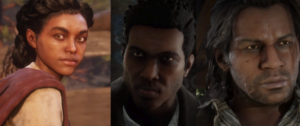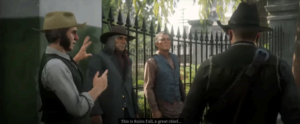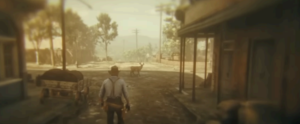88 Red Dead Redemption 2 (2018)
“Difference, Power, and Oppression in Red Dead Redemption 2”
by Hunter Kasper
Of all the stories I’ve experienced in my 23 years of life, none have left a more significant lasting impact than the tale of Dutch Van Der Linde and his fated gang of outlaws in the faraway year of 1899. The acting is all so vivid and lifelike and the motionscan technology translates that superb acting so well that despite Red Dead Redemption 2 being at its core a computer game, the narrative easily tops not only every other game before or since, but even surpasses some of the greatests westerns of all time, such as the 1976 classic, The Shootist. The game also stands as the longest Western ever written, far surpassing the previous record holder, the 2016 4-season long epic Westworld. Through examining character’s relationships with the law and morality, the narrative perfectly displays the colossal changes in power, difference, and oppression that defined 1899 in real history. Through the story’s ensemble cast, over 50 different perspectives on life and privilege are explored. Let’s examine how this was done, through visual and narrative design.
The game Red Dead Redemption 2 is set in an era of rapid industrialization and urbanization. In the words of the game’s writer, Dan Houser: “Both intense liberal progression and intense conservatism are both very militant, and very angry. It is scary but it’s also strange, and yet both of them seem occasionally to veer towards the absurd. It’s hard to satirize for those reasons. Some of the stuff you see is straightforwardly beyond satire. It would be out of date within two minutes, everything is changing so fast.” The days of the frontier are numbered, and the strong arm of the law is beginning to rule the entire United States. By placing us in the shoes of Arthur Morgan, a hardened but good man deep into the outlaw lifestyle, acting as the vice president of the Van Der Linde Gang, one of the last desperado groups left in the world, we get an incredibly unique perspective on how these world-changing events are affecting everyday people, no matter their occupation’s legality. The U.S. government is in its formative years. Pinkertons are everywhere and fugitives have nowhere left to run. But some people, like the gang’s leader, Dutch, aren’t ready to accept that reality yet. It is ultimately this childish denial of fact that drives the leader to madness and most of the gang to death.

I believe the best way to examine how this game handles differences is to look at three minority characters, Tilly, Lenny and Charles. So often in media, we see the token black trope, a singular black character usually in an all-white cast, used as either comic relief or to avoid/mitigate possible discrimination claims. That is not how RDR2 is written. Each of these characters has their own reasoning for joining the gang, breaking the law and stealing from others. Tilly is loyal to the gang because they saved her from an abusive home situation long ago. After years of having nothing, she wants it all. Lenny fights for Dutch to feel like he can belong, since inside the gang is where he spends the most time with Arthur, who couldn’t care less about race. Charles trusts Dutch so he can guarantee his own safety. Being born to an African American father and a Native American mother, Charles was vehemently disrespected almost everywhere he went, except for the Van Der Linde gang. Through thoroughly fleshing out all three of these characters, the game communicates that even in the different, the uncommon, there is still difference. However there is still similarity as well. All three are outcasts who found a place they can call home.

Discrimination and oppression have never been better represented in the medium of games than in RDR2’s 6th chapter. In this arc of the story, Arthur befriends two natives in town, both of the Wapiti tribe. One is named Rains Fall, and is the chief of their village. The other is his son, Eagle Flies. Before continuing it is interesting to note that not only are both the actors who portray these characters actually of native descent, but special actions were taken to not offend any specific real-life tribes. Rains Fall and Eagle Flies are even named with proper formatting and capitalization consistent with real history of the way first peoples in this country were named. Noah Caldwell, a popular independent game critic, describes rainfall’s tribe in his video Home, Home on the Console as such: “Wapiti is not an actual tribe, the word is an english bastardization of the first people’s word for elk, but in a way this is more graceful than adapting a real people into a fictional world. The audience can focus on how the Wapiti play into the trends and histories of how the first peoples have been treated in America without being quite so accountable for the particulars of how they weave it into the story.”
In this way, Rains Fall and Eagle Flies can be more representative of the suffering the government really did put first peoples through without contradicting history. By making the Wapiti more of an idea than a retelling, it allows multiple perspectives to be explored even inside the tribe itself. Eagle Flies is tired of the abuse from the government and wants to strike back. Rains Fall warns of an early grave this action will surely cause and simply wants peace for his tribe. All the while, Dutch just wants to play both sides, his own greedy act of discrimination. Dutch Van Der Linde murders Leviticus Cornwall in broad daylight against Arthur’s wishes.
While characters such as the Wapiti have little to no power, other figures like the wealthy land tycoon Leviticus Cornwall wield far too much. Abuse of power is evident everywhere. All members of the Van Der Linde gang carry guns to ensure power in confrontations and assert dominance over the innocent. Though the pinkertons claim to carry weapons to help exterminate criminals like the gang, they also use their power to inhumanely abuse and kill the natives. The game’s message is ultimately that too much power, too much freedom and not enough compromise will never be a winning balance. Dutch kills hundreds to live life “his way”, ultimately leading to the murder of his own wife and eventually attacking someone too powerful to assassinate. His stubborn insistence on sacrifice for the greater good wears thin when all he would have to do to end the violence would be to sacrifice some of his own time at a job; to live not simply for himself. The deeper into his twisted mentality that the leader slips, the less friends and allies are even left alive to stand by his side, and in the end, he leaves a loyal and gravely wounded John Marston to die twice, serving as Dutch’s final turning point into a completely selfish figure with no regard for others.
When it comes to the world of video games, there are thousands of choices at any one time for consumers. Xbox Game Pass, a $10 per month modern subscription service, offers hundreds of games on its service at once for anyone willing to pay the fee. With so many choices on the market, why do I gravitate towards RDR2? I do so because the story makes me think harder than any puzzle game could ever dream of doing. The incredible technological proficiency, professional-grade voice acting and high-class writing elevate the narrative to such a high level of sophistication that I would be doing myself a disservice as both a player and someone who frequently reads if I were to ignore it. When high standards are achieved, it’s important that they are celebrated. The public agrees. RDR2 has sold 61 million units worldwide in its six years on the market. Any splash that big can’t be ignored.
We have talked a lot about the big picture, but let’s zoom in on the best scene in this story, and analyze why Red Dead Redemption 2 is, above all else, important as art. The following scene is a rare example of a video game surpassing a movie creatively in my opinion. At the beginning of this essay, I mentioned the 1976 film The Shootist, and I want to explain why I think this game really is a better Western and a better story than that film. John Wayne’s portrayal of a cowboy with lung cancer was seen as incredible acting at the time. There was a good reason for that. Though he wished to hide it from the public, the actor was battling a similar lung cancer in real life. According to his personal website: “Considered at the time to be a taboo topic, Wayne was encouraged to keep news of his lung cancer diagnosis private. Unconcerned with the impact on his image or career, he didn’t heed such warnings, telling the press, “there is a hell of a lot of good image in John Wayne beating cancer.” Though he would lose a lung in battling the disease, it did not stop him from continuing with physically challenging and demanding roles until his death”. Despite the fact that John Wayne literally did have the cancer that Roger Clark, Arthur’s actor, is only pretending to have, I truly believe that the framing, coloring, cinematography, and acting in RDR2’s chapter six intro is simply the best scene I’ve ever witnessed and truly incredible acting, even better than some of the greats like Clint Eastwood or Charles Bronson.

Setting the scene, Arthur falls off his horse in the middle of town on a hot June day on his way to an important job. A good samaritan drags him to the doctor and he is admitted, all the while wheezing and coughing. Turns out that karma is catching up with him and he has contracted tuberculosis, likely from beating a man who owed the gang near death months ago. Immediately the audience can notice subtle changes, such as how Arthur’s eyes are bloodshot red and his skin is starting to pinken. He raises himself from the chair, thanks the doctor as the man lights his pipe, and walks out into the blinding sun. For a brief few seconds everything in the frame is bathed in white. The city is suddenly completely empty besides Arthur, and for the player, that means besides you. He squints in the sun and sees an elk walk directly through the empty town. It pauses and turns to him. Five mysterious seconds pass with the two simply looking at each other. Then the elk turns away and vanishes into a crowd as suddenly people begin to reappear around Arthur. A perfect scene, really.
I believe any piece of work that is able to achieve such a perfect balance with such a massive cast and insane runtime needs to be seen by most people who want to discuss games and stories critically. It is an excellent entry point into the series, despite the 2, because it tells a prequel story. But do not let that sway your opinion on the sheer quality, quantity, and incredible societal commentary this plot contains. It’s a story that everyone who is of age should experience. The issues portrayed are still occurring today. The Standing Rock Protests aren’t even five years old and treaties regarding first peoples are still being violated all the time. The lessons the game can teach about power, difference, oppression, greed, ambition, and friendship are valuable, positive and tangible additions to society and to art. And for that, I think it is an essential cultural creation.
CITATIONS
“John Wayne’s Life: A Timeline.” John Wayne Enterprises, www.johnwayne.com/about/john-waynes-life/.
“Home, Home on the Console: From Red Dead Revolver to Red Dead Redemption 2.” Www.youtube.com, www.youtube.com/watch?v=2utf6yph_QQ&t=12010s Accessed 15 Mar. 2024.
Nast, Condé. “Red Dead Redemption 2: The inside Story of the Most Lifelike Video Game Ever.” British GQ, 24 Oct. 2018, www.gq-magazine.co.uk/article/red-dead-redemption-2-interview. 9

